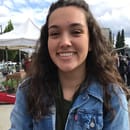Last year, on somewhat of a whim, I applied to be a Health and Wellness Crew (HAWC) member at Seattle University. When I got the email telling me I was being offered a position, I was excited and scared. I was thrilled to have a leadership role on campus, but imposter syndrome immediately kicked in. HAWC members act as certified peer health educators, meaning we have been trained to help students in crisis. We plan events surrounding mental health, physical wellness, healthy relationships, and alcohol and other drugs. HAWC’s values align very well with my own, but up until this quarter, I kept questioning whether or not I was good enough to be a HAWC member. After two quarters of planning events and helping people in crisis, I finally feel like I belong in the room.
There are two events that every HAWC team puts on. One is De-Stress With Dogs, by far our most popular event. It happens at the end of every quarter. The other is Take Back the Night. Take Back the Night is a national event dedicated to empowering survivors of sexual violence. When our advisors asked us who wanted to co-lead the event, I all but jumped out of my seat to volunteer. Katie Anderson, another HAWC member, was just as excited, and we were named co-leads. Katie had attended Take Back the Night our freshman year, and she knew what she liked and what she wanted to change. I didn’t go, but I’m passionate about breaking the silence around all power-based violence, and I was excited to work with her. We almost immediately started planning, wanting to make the event as inclusive and empowering as possible.
For those of you who may not know, Take Back the Night is divided into four parts: the march, the vigil, community speakers, and open mic. These parts can be done in whatever order the event planners desire, and other portions may be added, but in order for the event to be registered as Take Back the Night, these four parts must take place at some point during the event. What was most important to Katie and me was the vigil and the open mic, so we decided to stick with the four basic parts in order to leave ample time for what we deemed the most significant portions. Katie was really unhappy with how the march had gone down the previous year, so we put most of our energy into working on revamping that. In the end, we decided to do a silent march through the Student Center and to the secret garden behind Campion Hall where an act of sexual violence took place last year, leading the school to close the back entrance to the Cave (a convenience store in our basement). Everyone in the march would carry glow sticks to symbolize that we are here, whether we’re a survivor or an ally, and we would not be silenced or stop listening to survivors.
The next part was the vigil which we agreed to keep the same. We would stand in a circle around a table with two glass jars: one full of marbles, the other empty. We would take turns dropping a marble into the empty jar to represent everyone we know who has been impacted by sexual violence. The activity would be silent so that we could hear each marble clinking in the jar as well as watch the second jar fill up.
The speaker portion was the most frustrating to plan. The previous year there had been four speakers, and Katie and I agreed that was too much. We cut it down to two speakers, immediately finding one and constantly emailing the other to find out whether or not they were really coming, because they agreed to speak but then kind of ghosted us for two weeks. Luckily, they showed up, but the speaker portion of the evening was by far the most stressful part of planning for me, as I was the person trying to find the speakers.
The open mic portion took very little planning. There would be two microphones at the front of the room, and survivors of sexual violence, domestic abuse, or any instance of power-based personal violence could come to the front and share their story in a safe, nonjudgmental, non-reporting space.
Now, I attend a small university. Despite all the energy and effort that goes into planning events for HAWC, we rarely have more than ten people show up for events (with the exception of De-Stress With Dogs). It’s easy to get discouraged when this is the case. There were two moments that told me Take Back the Night would be different. The first one was me asking my boyfriend if he was coming, and him replying, “No, I don’t need to take back the night.” I immediately went into how he didn’t have to come, but he couldn’t have that mentality as a cisgender white man because he was indirectly continuing the cycle of silencing survivors of sexual violence. We had a very productive conversation, and in the end, he came of his own accord. The second was me telling my roommate I hoped people actually showed up. She very simply told me, “Anyone who needs it will be there.” In that moment, it became about quality over quantity. If one person showed up and left feeling accepted, understood, and empowered, I would be happy.
Finally, after about three months of planning, the day arrived. Of course, nothing went as planned. The time stamps we had come up with went out the window. We started the march late because we wanted to give people the chance to grab some dinner before coming. When we did finally start, I felt strange. A group of about fifteen people were marching through campus, Katie and I in front holding a sign that said, “Silent march for Take Back the Night.” Everyone looked at us, as we had planned. I felt awkward. I don’t really like to be the center of attention, and for a few minutes I found myself wishing I hadn’t volunteered to stay in the front of the march. Then we got out of the student center. Suddenly, people were averting their eyes. As soon as they read our sign, they were looking away, doing their best to pretend we weren’t there. I realized how uncomfortable we made some people, and that made me angry. We need to start talking about sexual violence in an open, candid way. People who have never experienced sexual violence can’t keep ignoring it because it makes them uncomfortable because that further isolates survivors. In planning the event, there were multiple times where I was told I needed to think in a more trauma-informed way. Sometimes I felt embarrassed, but I’ve realized that it’s essential that we give survivors a place to share their story and to let them know that we believe them. The march helped me cement just how important an event like Take Back the Night is.
Next came the vigil. By this time, more people had joined us, and we had about thirty people in the room. We circled up, and Katie started, taking marbles out of one jar and placing them in the other. I went next, hoping to break the ice and encourage others to come to the center of the circle whenever they were ready. Some people dropped three marbles. I dropped in seven, though throughout the event my heart ached as I realized I knew way more than seven people who have been directly impacted by sexual violence. Some people came to the center of the circle and grabbed four handfuls of marbles, letting them clink their way into the second jar. A couple people shed a few tears. Every single person in the room dropped at least three marbles into the second jar. The vigil was meant to symbolize how everyone is somehow connected to the issue of sexual violence, and therefore we need to all work to stop it. It was a very moving representation.
Following that came the speakers, which went about how I anticipated. We had two nurses speak about their experiences helping survivors of sexual assault. They were supposed to wrap up around 7 PM, but we finished up the speaking portion at 6:30. Then it was time for the open mic.
I didn’t really know what to expect. There was a lot of silence as people in the room thought about their experiences or the experiences of people they know. I don’t know how long passed before someone came to the front of the room; I didn’t check the clock. By this point, I could hear people sniffling, but I myself had not cried. I thought I might get away with not crying because I had planned the event, and I thought I kind of knew what to expect of the event as a whole. When the first person came to the front of the room and shared their story, I could feel a knot in my stomach. Sometimes a long time would pass before someone came to the front of the room; sometimes no time at all passed. With every speaker, more people in the audience would cry. I myself started crying when someone I know and care about greatly got up and talked about their experience, and I didn’t really stop crying until the event was over. People were incredibly vulnerable. One person said they wished there were more spaces like that, where people could speak openly about their experiences and still be seen as people, not victims.
I walked away from the event with a new understanding about why talking about sexual violence is so incredibly important. It’s something HAWC members get a lot of training about, and something I’ve discussed with students as they come in needing help. It’s different being in that room for an event like Take Back the Night and seeing the difference a space where people will be believed can make. Some people had told their story before, and expressed that it’s gotten easier to talk about it the more they do. Others shared that it was their very first time talking about what happened to them. Take Back the Night is an important event, a necessary event, and I’m honored that I had such an intimate part in making it take place, as well as simply giving survivors a place to exist in.
I wish there was some sweeping declaration I could make that would stop all instances of power-based personal violence and heal the scars of all survivors. I’m not naive enough to think there is, but I do know that we all have a role to play. At Seattle University, Green Dot trainings happen throughout the year, teaching students how to be an active bystander in situations where sexual violence may occur. But helping people doesn’t even need to be that formal. At the very least, be a safe place for survivors. Listen when they talk. Help them when they ask for it. Support them. Believe them. Maybe there’s not any immediate, large-scale change that we can make, but we absolutely can make a difference in a survivor’s life. If they decide to speak up about their trauma, at the absolute bare minimum: believe survivors.



